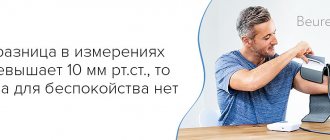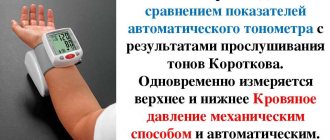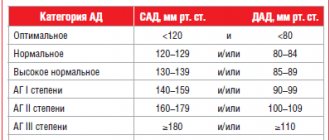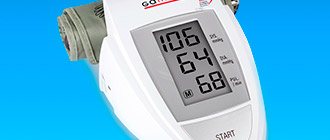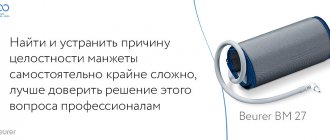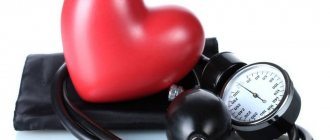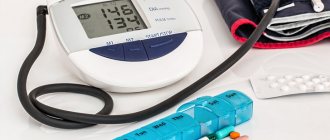High blood pressure Testing for a genetic predisposition to hypertension can help identify causes of high blood pressure. Cost of examination
Hypertension The presence of hypertension implies a genetic predisposition. How can the disease be confirmed?
Why are high cortisol levels dangerous? High cortisol levels can lead to high blood pressure and blood sugar levels, obesity, and thinning skin. Get tested
Preventive examination Regular checks of biochemical parameters of the body help to identify various diseases in a timely manner. Where can I get tested?
Tests at home You can take the necessary tests without leaving your home. Call a specialist to your home
Promotions and special offers Special offers and discounts on diagnostic laboratory services allow you to save on medical examinations. View current promotions
Blood pressure has such a huge impact on our health and well-being that it is important to monitor it, especially in adulthood.
Blood pressure is one of the main indicators of the body’s condition, and its measurement is a mandatory part of a comprehensive health examination. Even a slight deviation from the norm can be risky. It should be noted that problems with blood pressure occur at different ages, both in elderly and very young people.
Why do you need to measure blood pressure?
Blood pressure is the force of blood with which it acts on the walls of arteries and blood vessels.
There are diastolic (lower) and systolic (upper) pressure. The norm for an adult is around the boundaries of 120 to 80 mmHg. Significant deviations from these figures often signal the emergence of some disease. Jumps in blood pressure increase the risk of heart attack, ischemia, and stroke.
Increased levels can be observed with the development of the following pathologies:
- heart rhythm disturbances;
- vascular diseases;
- renal failure;
- endocrine diseases;
- neurological disorders.
Low blood pressure is caused by: internal hemorrhages, heart failure, aggravated stomach ulcers, stress, vegetative-vascular dystonia, depression.
It is worth noting that reduced levels may be an individual characteristic of the body. However, high blood pressure almost always signals problems in the body.
To find out exactly the reasons for the jumps, you need to regularly monitor your condition, take measurements, and be examined by a doctor.
Losartan
Tablets for blood pressure from the group of angiotensin receptor blockers.
Losartan is used to lower blood pressure with concomitant pathologies (for example, diabetes or heart failure).
The drug reduces the load on the heart, helping it receive enough oxygen. Losartan is prescribed for hypertension, to reduce the risk of mortality in case of left ventricular hypertrophy, to reduce the load on the kidneys in diabetes mellitus, and to treat chronic heart failure when other drugs do not give the desired effect. Contraindications:
these blood pressure pills should not be taken while being treated with ACE inhibitors (especially if you have kidney disease), while being treated with drugs to lower blood sugar levels, or if you are lactose intolerant.
Losartan
JSC VERTEX, Russia
Arterial hypertension.
Reducing the risk of associated cardiovascular morbidity and mortality in patients with arterial hypertension and left ventricular hypertrophy, manifested by a combined reduction in the incidence of cardiovascular mortality, stroke and myocardial infarction. Protection of the kidneys in patients with type 2 diabetes mellitus with proteinuria - slowing the progression of renal failure, manifested by a decrease in the incidence of hypercreatininemia, the incidence of end-stage renal failure requiring hemodialysis or kidney transplantation, mortality rates, as well as a decrease in proteinuria. Chronic heart failure (as part of combination therapy, with intolerance or ineffectiveness of therapy with ACE inhibitors). from 30
1160
- Like
- Write a review
Pressure measurement methods
There are 2 types of manipulations for measuring blood pressure: direct and indirect. The direct method is highly accurate, but physically traumatic. A pressure gauge needle is inserted into the wall of the heart or artery. The tube of the device is filled with an anti-clotting agent. The scribe records blood pressure fluctuations in the form of a curve. The technique is used by cardiac surgeons, sometimes in laboratory conditions.
Indirect pressure measurement is a non-invasive method. The measurement is carried out on the peripheral vessels of the elbow or wrist using a tonometer. There may be errors, but the device can be used in any conditions.
Indirect diagnostics of pressure according to the type of technology used (mechanical, electronic) is divided into auscultatory and oscillometric options.
Auscultatory method
Also known as the Korotkoff method. Named after its inventor, surgeon N.S. Korotkova. Mechanical tonometers are used. The cuff is secured to the shoulder and inflated with air through a pear-shaped balloon. The upper and lower limits of pressure are determined by ear using a phonendoscope.
When the cuff is inflated, the blood flow in the artery is blocked, the external pressure exceeds the systolic pressure, and the characteristic sound pulsation stops. The gradual release of air restores blood movement, and tones begin to be heard again. The first beat corresponds to systal (upper) pressure, the last – diastolic (lower).
The Korotkov method is recognized as standard. It has its positive and negative sides. Even an accidental hand movement will not affect the result. However, there is a risk of incorrectly applying the cuff and stethoscope. The objective determination of pressure indicators can be interfered with by noise in the room. The device consists of many parts; during its use, a considerable number of manipulations are expected, so you need to learn how to measure pressure correctly.
Oscillometric method
Electronic tonometers with automatic or semi-automatic control are used. The cuff is attached above the elbow or on the wrist. In a fully automatic system, air is drawn in and released independently. In a semi-automatic machine, you must use a bulb. The indicators are displayed on the display without outside help based on the recorded pulsation.
The advantages of this method include the rapid preparation of the electronic device for operation. In addition, working with it does not require special skills, there is no error in human attention, and the noise in the room is not important.
In order for the indicators to be determined correctly, the hand must be motionless while measuring pressure. It is also forbidden to talk during the procedure.
Diagnostics
The following laboratory and clinical methods are prescribed to determine the subsequent tactics of action:
- blood test (general, biochemical);
- electrocardiogram to prevent impending complications (angina pectoris, myocardial infarction, stroke).
The doctor can issue a referral for:
- echocardiography;
- electrocardiography;
- angiography;
- MRI;
- X-ray of the thoracic spine.
Jumps occur with disorders of the renal system, so an ultrasound of the kidneys and a biochemical urine test are prescribed.
How to measure pressure correctly
The most accurate result of this diagnosis can be obtained by following certain rules. Distorted indicators will not provide the necessary information content and may lead the patient and doctor to a false conclusion.
Preparation for the procedure
It is recommended to measure blood pressure an hour or more after fitness or smoking. Coffee, tea, energy drinks, a hot shower or bath require you to wait 1.5-2 hours. You should also wait 15-20 minutes. after eating.
It is advisable to empty the bladder and intestines before measuring pressure.
Before starting the diagnosis, you need to sit or lie down for 2 to 10 minutes. The posture during the measurement process should be relaxed, sitting, legs not crossed, not tense. The cuff should be placed correctly on the arm at the same level as the heart. The patient must remain silent.
Before measuring pressure, it is recommended to ventilate the room and ensure a comfortable air temperature.
Mechanical measurement algorithm
- Prepare the device. Remove the tonometer from the packaging and place the meter on a flat surface, ensuring a good view of the dial. Straighten all the tubes.
- Put on the cuff. Wrap the material around your bare forearm (2-3 cm above the elbow). Fasten tightly, but not too tight.
- Install a phonendoscope. Place the membrane under the cuff just above the elbow (on the inside of the arm). Insert headphones into your ears.
- Inflate the cuff. Take the bulb in your palm and tighten the valve tightly in a clockwise direction until it stops. Squeeze the bulb with quick movements until the cuff is filled with air and the monometer needle reaches 180 mm Hg. At this stage, a slight numbness of the arm may be felt due to blockage of blood flow in the artery.
- Start the measurement itself. Slowly open the bulb valve counterclockwise, gradually releasing air. In this case, it is necessary to monitor the dial needle and the tone in the ears. The first beat heard will occur at the systolic pressure mark, the last one at the diastolic pressure mark. Remember these indicators.
- Finish the procedure. As soon as the beats in the headphones have completely stopped, you can deflate the remaining air, remove the cuff and stethoscope, and put away the device.
If you were unable to listen to the readings, you can inflate the cuff again during the measurement process. You cannot repeat the manipulation more than once, because this distorts the data.
Electronic measurement algorithm
- Preparing the device. Place the tonometer body on a flat surface and straighten all the tubes well.
- Prepare your hand. Take off your watches, bracelets, roll up your sleeves.
- Put on the cuff. Place the fabric on the forearm above the elbow 2 cm.
- Patient preparation. Take a relaxed sitting position with straight legs. Keep your hand calm, it is better to rest it on the table with your palm up. Shut up and breathe evenly for about 30 seconds.
- Measurement. Press the start button according to the instructions. The cuff will begin to inflate and running numbers will appear on the screen. Without changing position, wait until the air is completely deflated and the readings on the monitor stabilize.
- Remove the device. Remove the cuff and stop the device.
When measuring with a wrist tonometer, you should also remove jewelry from your hand and expose your skin. The cuff is put on with the display up 1 cm above the hand. The hand with the device is placed palm down on the opposite shoulder. This is followed by startup, inflation of the cuff, appearance of indicators and deflation.
For maximum accuracy, the diagnosis can be repeated after 15 minutes.
Prevention and control
Additionally, patients are recommended to:
- spend more time in the fresh air;
- normalize sleep patterns;
- to refuse from bad habits;
- avoid stress;
- fight excess weight;
- reduce the amount of salt you consume.
This applies more to people with a hereditary predisposition, if relatives previously suffered from hypertension. Patients with arterial hypertension are registered with a cardiologist.
As a prevention or treatment of arterial hypertension, the emphasis is on restoring the activity of immune cells. The main thing is not to conduct experiments on your health.
The material was prepared specifically for the website venaprof.ru, edited by doctor N.A. Glushakova. Specialty: therapy, cardiology, family medicine.
Measurement errors
An important condition is not to touch the phonendoscope membrane and cuff with your hands during the measurement process. Pulse from holding fingers will distort the readings. The tissue between the skin and the cuff interferes with the membrane's receptivity.
You cannot deviate from the level of the heart in the position of the cuff; the numbers will turn out to be too high or too low. The same result will be achieved if the Velcro is fastened too loosely or too tightly, a tired state, a hunched back, or the patient moving and talking.
When using a mechanical tonometer, you should not choose to round the indicators to 0 and 5. Only the actual data shown is taken as truth.
When and which doctor to contact
Do not hesitate to contact a specialist if alarming signs appear.
If after measurements the values do not correspond to the norm, you should visit your local physician. It will reveal the degree of deviations and heart rate. After receiving the test results, the doctor will redirect you to other highly specialized specialists - a neurologist, endocrinologist, cardiologist.
Deviations from normal values may be caused by a decrease in kidney function. It is possible to refer the patient for consultation to a nephrologist.
Interpretation of indicators
The blood pressure of an adult is distributed by doctors as follows:
- optimal. 120 by 80 units and slightly lower;
- normally acceptable. Up to 130 to 85;
- moderately elevated. Up to 139 to 89.
Numbers above the moderately elevated limit indicate hypertension.
Children's blood pressure may have different standards depending on age; they are determined by the doctor.
Symptoms of hypertension
Signs of pathology are the following conditions:
- Headache, often in the occipital region. May not respond to analgesics.
- Pulsation in the head, noise in the ears.
- Dizziness may occur with a sudden change in position.
- Decreased visual acuity, darkening of the eyes, sensation of “floaters”.
- Chills, increased sweating, rapid pulse, nausea.
- Nose bleed.
- Redness of the face and ears.
- Feelings of anxiety, restlessness, increased fatigue.
Symptoms may indicate more than just hypertension, but when one or more conditions appear, it is recommended to first measure blood pressure. If the values are higher than normal, consult a therapist or cardiologist.
Pressure monitoring
Monitoring refers to repeated measurements over a certain period. This practice is used to select the right medications, control pregnancy, and certain diseases. The doctor may prescribe diagnostics at regular intervals, at set hours, require you to keep a blood pressure diary or wear a smart blood pressure monitor with a memory function. The latter option is more expensive, but is convenient for recording more than 100 indicators with the date and time of measurement without the participation of the patient.
Determining blood pressure using devices is used everywhere in everyday life and medicine. Different tonometers have their own errors and advantages. It is better to buy a specific type after consulting a supervising doctor, taking into account the situation.
Who's at risk
Monitoring blood pressure levels should begin at a young age for people at risk for this pathology.
Risk factors for hypertension:
- heredity;
- obesity;
- physical inactivity;
- frequent headache;
- exhaustion of the body due to chronic fatigue, prolonged nervous strain or neglect of proper rest;
- addiction to foods included in the list of “harmful” (fried, salted, smoked, stimulating the nervous system);
- bad habits (consumption of alcohol and nicotine leads to narrowing of the lumen of blood vessels and increased heart rate);
- chronic kidney disease;
- age over 55;
- uncontrolled treatment with drugs (especially NSAIDs and hormonal drugs);
- diabetes.
The more risk factors present in a person's life, the greater the likelihood of developing hypertension.

